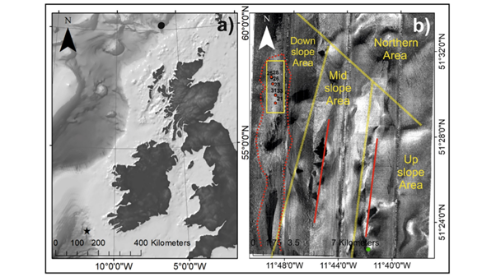Classifying sediment waves - An update from Gerard

Gerard Summers, one of our PhD Researchers, has been hard at work creating a workflow that will allow semi-automated processing of seabed sediment wave data.
 Happy new year to everyone, we hope that yours was a relaxing and festive time. We have been keeping the nose to the grindstone coming up with innovative ideas and techniques.
Happy new year to everyone, we hope that yours was a relaxing and festive time. We have been keeping the nose to the grindstone coming up with innovative ideas and techniques.
Gerard has been hard at work creating a workflow that will allow semi-automated processing of seabed sediment wave data. The focus of this workflow are coldwater habitats, specifically the downslope area of the Moira Mounds in the Belgica Mound Province. See map to right taken from Lim et al. (2018):
Several studies have described the effects of underwater currents on the formation and development of these mounds and the sediment waves surrounding them. Sediment waves are formed by consistently flowing currents that reshape the underlying seabed into a peak and trough. The exact shape of these sediment waves is influenced by the current speed, with slower currents producing longer, straighter waves. Curves in these waves develop and the wave height, and grain size of the sediment increases when the current speed increases (see models based on Stow et al. 2009).
These sediment waves have been shown to provide an accurate estimate of average local current speeds. We hope to exploit this property by developing local estimated current speeds for the entire region, providing further understanding of how the filter feeding corals influence their surroundings to get their food.
 Gerard is busy creating a workflow that will break down the wave number (number of waves within a given distance), wavelength (distance between 2 waves), and wave height (the height of the wave from peak to the trough). These properties will help to provide current speed measures for each sediment wave. We have real data plotted to the right to give you a flavor of this analysis.
Gerard is busy creating a workflow that will break down the wave number (number of waves within a given distance), wavelength (distance between 2 waves), and wave height (the height of the wave from peak to the trough). These properties will help to provide current speed measures for each sediment wave. We have real data plotted to the right to give you a flavor of this analysis.
This type of research is not restricted to coldwater coral habitat and the researchers in the MGRG believe that this will feed into offshore engineering projects, including prospective windfarm sites.
What is more, the software that Gerard is using is to analyse this data is opensource. So once this research is complete it can be accessed by anyone in the public. Previous work that Gerard has released can be access in the following link.
References
LIM, A., HUVENNE, V. A. I., VERTINO, A., SPEZZAFERRI, S. & WHEELER, A. J. 2018. New insights on coral mound development from groundtruthed high-resolution ROV-mounted multibeam imaging. Marine Geology, 403, 225-237.
STOW, D. A., HERNÁNDEZ-MOLINA, F. J., LLAVE, E., SAYAGO-GIL, M., DÍAZ DEL RÍO, V. & BRANSON, A. 2009. Bedform-velocity matrix: the estimation of bottom current velocity from bedform observations. Geology, 37, 327-330.
Marine Geosciences Research Group
University College Cork
Contact us
School of Biological, Earth and Environmental Sciences, North Mall Campus, University College Cork, North Mall, Cork City, T23 TK30
